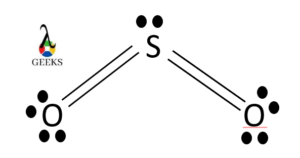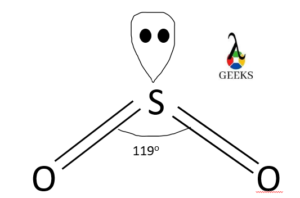Sulphur dioxide (SO2) is an inorganic toxic compound. Let us elaborate on some important facts about sulphur dioxide.
SO2 is present in mild concentrations in Earth’s atmosphere but is one of the significant gases in the atmosphere of Venus. Volcanic eruptions emit a large amount of SO2. When it mixes with water and air, it produces acid rain and contributes to air pollution.
In this article, some significant facts and properties of sulphur dioxide, such as IUPAC name, colour, odour, density, structure, and reaction with acids are discussed.
SO2 IUPAC Name
The IUPAC (International Union of Pure and Applied Chemistry) of SO2 is Sulphur dioxide.
SO2 Chemical Formula
Sulphur dioxide has the chemical formula SO2. It consists of one sulphur atom bonded to two oxygen atoms.
SO2 CAS Number
The CAS number (authentic numeric identifier which can contain upto10 digits) of sulphur dioxide is 7446-09-5.
SO2 Chemspider ID
The ChemSpider ID (ChemSpider is a free chemical structure database) for sulphur dioxide is 1087.
SO2 Chemical Classification
Sulphur dioxide is an inorganic substance which has two oxygen atoms (hence the prefix ‘di’) covalently bonded to a central sulphur atom in a bent shape.
SO2 Molar Mass
The molar mass (mass of one mole of a substance) of sulphur dioxide is 64.066 g/mol.
SO2 Color
Sulphur dioxide is a colourless poisonous gas.
SO2 Viscosity
The viscosity of sulphur dioxide is 12.82 μPa.s
SO2 Molar Density
The density of sulphur dioxide is 2.6288 kg/m3.
SO2 Melting Point
The melting point of sulphur dioxide is -72 °C (201 K) or -98 °F.
SO2 Boiling Point
The boiling point of SO2 is -10 °C (263 K) or -14 °F.
SO2 State at Room Temperature
SO2 exists as a gas at room temperature. Vander Waals force of attraction (the weakest force of intermolecular attraction) exists in the molecule and creates discrete units. Thus, SO2 exists in gaseous form at room temperature.
SO2 Covalent Bond
SO2 is a covalent compound. The electronegative difference between sulphur (2.5) and oxygen (3.5) is very less and hence mutual sharing of valence electrons takes place between the two atoms to complete their octet resulting in the formation of a covalent bond.

SO2 Covalent Radius
Sulphur dioxide is a molecule with double bonds between sulphur and oxygen. Such molecules do not possess a covalent radius.
SO2 Electron Configurations
Electronic configurations describe how the electrons are distributed in atomic orbitals. The electronic configuration notation of sulphur dioxide is given below.
- Ground state electronic configuration of S: 1s2 2s2 2p6 3s2 3p4.
- Ground state electronic configuration of O: 1s2 2s2 2p4.
SO2 Oxidation State
Sulphur in sulphur dioxide is in a +4 oxidation state and that of oxygen is -2. Sulphur in SO2 can lose or gain two electrons to get an oxidation number of +2 and +6 respectively. Thus, SO2 behaves both like a reducing and oxidizing agent.
SO2 Acidity
The nature of SO2 is acidic as it readily dissolves in water forming a weak acid, viz., sulphurous acid (H2SO3). Moreover, it turns blue litmus red.
Is SO2 Odourless?
Sulphur dioxide is a pungent gas with the choking smell of a burnt matchstick.
Is SO2 Diamagnetic?
The diamagnetic property of a substance refers to the absence of unpaired electrons with no net dipole moment. Let us discuss whether SO2 is diamagnetic or paramagnetic in nature.
Sulphur dioxide is diamagnetic in nature. The valence shell of sulphur has 6 electrons and the valence shell of oxygen molecule has 12 electrons. So, in total, there are 18 (even number) paired valence electrons in the SO2 molecule.
SO2 Hydrates
SO2 exhibits a reducing character in water as it evolves nascent hydrogen and gets itself oxidized to sulphuric acid.
- SO2 +2H2O → H2SO4 + 2[H]
SO2 Crystal structure
- The shape of SO2 is triangular planar according to the geometry of electrons in SO2. However, the shape is bent or V-shaped according to its molecular geometry.
- Sulphur has a lone pair of electrons. In SO2, the lone pair-bond pair repulsion is stronger than the repulsion between the two bond pair electrons. As a result, the bond angle is reduced causing a bent or V-shaped structure.

SO2 Polarity and Conductivity
- SO2 is a polar molecule with a net dipole moment of 1.62 Debye. SO2 molecule is angular in shape and oxygen being more electronegative, distorts the electron cloud creating a charge separation.
- The conductivity of sulphur dioxide is less as the sulphurous acid formed is a weak diprotic acid.
SO2 Reaction With Acid
SO2 does not react with acid as sulphur is a non-metal and is less reactive when compared to hydrogen.
SO2 Reaction With Base
SO2 being acidic, readily reacts with sodium hydroxide (base) to form sodium sulphite which further reacts with excess SO2 to form sodium hydrogen sulphite.
- 2NaOH(aq) +SO2 (g) → Na2SO3(aq) + H2O(l)
- Na2SO3(aq)+ SO2(g)+ H2O(l)→ 2NaHSO3(aq)
SO2 Reaction With Oxide
Sulphur dioxide reacts with calcium oxide to form calcium sulphite. This reaction is useful for the desulphurization of sulphur in coal-fired power plants.
- CaO + SO2 → CaSO3
SO2 Reaction With Metal
Active metals like magnesium and iron are oxidized in reaction to SO2.
- Mg + SO2 → 2MgO + MgS
- Fe + SO2 → 2FeO + FeS
Conclusion
Sulphur dioxide has a bent molecular structure with sp2 hybridization. It is highly water soluble and has both oxidizing and reducing properties. SO2 is a mild bleaching agent and is used as a solvent in industries.

Hi Everyone. I am Vishnupriya T. I have pursued a Master’s in Chemistry and a PG Diploma in Quality Management. Currently working as an SME in Chemistry, aiming to enrich my curiosity and knowledge. I would love to share knowledge and connect with others at my LinkedIn profile: